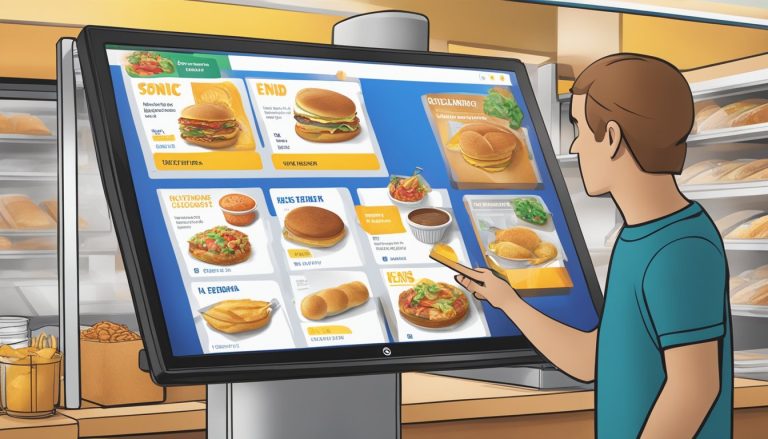Sonic’s breakfast marketing has evolved dramatically from its early days of radio jingles to today’s multi-platform social media campaigns. The fast food chain has continuously adapted its approach to reach customers during the crucial morning hours.
Sonic’s strategic use of audio branding and catchy slogans has been key to building brand recognition and driving breakfast sales. From memorable radio ads to eye-catching Instagram posts, Sonic has leveraged various media to showcase its morning menu offerings and entice hungry consumers.
The company’s marketing efforts now span traditional and digital channels, creating a cohesive brand experience across touchpoints. Sonic’s breakfast promotions on social platforms have allowed for more direct engagement with customers, while still maintaining the playful tone established in its earlier advertising. This multi-faceted approach has helped Sonic remain competitive in the crowded fast food breakfast market.
The Evolution of Sonic’s Marketing Strategy

Sonic Drive-In has transformed its marketing approach over the years, adapting to changing consumer preferences and technological advancements. The company has skillfully blended nostalgia with innovation to maintain relevance and appeal.
From Jingle to Audio Identity
Sonic’s iconic “Two Guys” commercials, featuring comedic conversations in cars, became a cornerstone of its audio branding. This approach evolved into a distinctive sonic identity that resonates across various media platforms.
The company’s audio logo, a catchy five-note melody, now serves as a memorable brand signature. This sonic element appears in TV ads, radio spots, and digital content, creating a consistent auditory experience for customers.
Sonic has also experimented with custom music tracks and collaborations with popular artists to further strengthen its audio presence. These efforts have helped solidify Sonic’s place in popular culture and enhance brand recall.
Leveraging Digital Marketing Channels
Sonic embraced digital marketing as a critical component of its strategy. The company developed a mobile app that provides a seamless ordering experience and integrates a loyalty program.
Social media engagement became a key focus, with Sonic creating entertaining and shareable content across platforms. The brand’s witty Twitter presence and visually appealing Instagram posts have helped cultivate a strong online community.
Sonic also leverages influencer partnerships and user-generated content to amplify its reach. These tactics have proven especially effective in connecting with younger, tech-savvy consumers.
Menu Innovation and Limited-Time Offers
Sonic’s marketing strategy heavily emphasizes menu innovation and limited-time offers (LTOs). The company regularly introduces new menu items and flavor combinations to generate excitement and drive traffic.
LTOs, such as seasonal shakes and unique flavor twists on classic items, create a sense of urgency and encourage repeat visits. Sonic strategically promotes these offerings through targeted digital campaigns and eye-catching in-store displays.
The brand also capitalizes on food trends and customer preferences, introducing healthier options and customizable menu items. This approach allows Sonic to cater to diverse consumer tastes while maintaining its core identity as a fun, innovative fast-food destination.
Building a Strong Brand Identity

Sonic branding plays a crucial role in establishing a recognizable and memorable brand identity. A well-crafted audio signature, consistent brand values, and emotional connections form the foundation of a strong sonic identity.
Crafting a Unique Audio Signature
A distinctive audio signature sets a brand apart from competitors. Sonic logos, like Intel’s five-note chime or Netflix’s “ta-dum” sound, instantly evoke brand recognition. These short, memorable audio cues become synonymous with the brand itself.
Companies invest in creating custom jingles or selecting specific music that aligns with their brand personality. This auditory element becomes a powerful tool for brand recall across various touchpoints.
Sound design extends beyond logos to encompass the overall audio experience. Brands carefully select voice actors, background music, and sound effects that reflect their identity and resonate with their target audience.
Consolidating Brand Values and Awareness
Sonic branding reinforces brand values and enhances awareness through consistent audio experiences. Companies integrate their audio signature across multiple platforms, from radio and TV commercials to digital content and in-store environments.
This consistency helps build brand recognition and recall. Consumers learn to associate specific sounds with the brand, creating a stronger mental connection.
Audio elements are carefully crafted to reflect brand attributes. For example, a luxury brand might use sophisticated orchestral music, while a youth-oriented brand opts for upbeat electronic tunes.
Brand awareness increases as the sonic identity becomes familiar to consumers. This familiarity breeds trust and loyalty, contributing to long-term brand success.
Positioning with Emotional Connections
Sound has a unique ability to evoke emotions and create lasting memories. Brands leverage this power to forge deeper connections with their audience.
Music and sound effects can trigger specific feelings, from excitement and joy to nostalgia and comfort. By aligning these emotional responses with brand values, companies create a more impactful and memorable brand experience.
Sonic branding also helps position a brand within its market. The choice of audio elements can convey sophistication, innovation, reliability, or other desired brand attributes.
Consistent use of sonic elements across touchpoints reinforces the brand’s emotional appeal. This emotional positioning helps differentiate the brand and fosters stronger customer loyalty.
Sonic Drive-In’s Iconic Advertising Campaigns
Sonic Drive-In has crafted memorable advertising campaigns that leverage creative storytelling, nostalgia, and emotional connections to build brand loyalty. These campaigns have helped solidify Sonic’s position as a beloved fast-food chain in American culture.
Creative Use of Sonic Assets
Sonic’s advertising often highlights its unique drive-in format and diverse menu. The brand’s iconic cherry limeade and other signature drinks frequently take center stage. In 2002, Sonic introduced the “Two Guys” campaign featuring comedians T.J. Jagodowski and Peter Grosz. Their humorous banter in parked cars became instantly recognizable. This campaign ran for nearly two decades, creating a lasting impression on viewers.
Sonic has also experimented with jingles and catchy slogans. “This Is How We Sonic” launched in 2020, showcasing real customers enjoying meals in their vehicles. The timing coincided with pandemic-related changes in dining habits, making the campaign particularly relevant.
The Role of Nostalgia and Emotion
Sonic taps into nostalgia by evoking memories of classic American drive-ins. Their ads often feature friends and families sharing meals in cars, reminiscent of bygone eras. This approach creates an emotional connection with customers, associating the brand with positive experiences and simpler times.
The company’s use of humor in advertising also plays on emotions. Funny exchanges between characters in commercials make viewers laugh and feel good about the brand. By consistently delivering lighthearted content, Sonic has built a reputation for fun and enjoyment.
Success Stories and Case Studies
Sonic’s “Two Guys” campaign stands out as a major success story. Its longevity and popularity demonstrate the power of consistent branding and relatable humor. The campaign helped increase brand recognition and customer loyalty over nearly 20 years.
In 2024, Sonic launched the “Live Free Eat Sonic” platform. This campaign introduced a fictional “Department of Research and Deliciousment,” creating a whimsical world around the brand. Early reports indicate positive reception, with the new approach refreshing Sonic’s image while maintaining its core identity.
The 2020 “This Is How We Sonic” campaign also proved successful. By featuring real customers, it created authentic connections during challenging times. The campaign’s focus on in-car dining aligned perfectly with pandemic-era consumer behaviors, showcasing Sonic’s adaptability.
Enhancing Customer Experience Through Sonic Elements

Sonic branding plays a crucial role in shaping customer perceptions and experiences at Sonic Drive-In. The company leverages various auditory elements to create a unique and memorable atmosphere for its patrons.
Sound Effects and Custom Soundscapes
Sonic Drive-In employs carefully crafted sound effects and custom soundscapes to enhance the dining experience. The distinctive “ding” of the intercom system serves as an audio signature, signaling the start of the ordering process. This sound has become synonymous with the brand, triggering anticipation and excitement in customers.
Custom soundscapes are designed to create a pleasant ambiance in outdoor dining areas. These audio landscapes blend natural sounds with subtle background music, helping to mask traffic noise and create a more enjoyable environment for patrons.
The use of branded audio cues extends to the Sonic mobile app, where custom notification sounds reinforce brand identity and improve user experience in the digital realm.
The Influence of Background Music
Background music at Sonic Drive-In locations is carefully curated to align with the brand’s identity and target demographic. The playlist typically features a mix of upbeat, family-friendly tracks that create a lively atmosphere without overpowering conversations.
Music selection varies throughout the day to match different meal times and customer moods. Breakfast hours might feature more energetic tunes to kickstart the day, while evening selections tend to be more relaxed.
Studies have shown that appropriate background music can influence customer behavior, potentially increasing dwell time and encouraging repeat visits. Sonic leverages this knowledge to create a positive auditory environment that complements its menu offerings and overall brand experience.
Integration with Digital Media and Tech
Sonic Drive-In has embraced digital technologies to extend its sonic branding beyond physical locations. The company’s mobile app incorporates branded audio elements, creating a consistent experience across platforms.
Voice assistants and smart speakers now feature Sonic’s audio signature in advertisements and when processing voice orders. This integration helps maintain brand recall in the growing voice-activated ecosystem.
Social media campaigns often include audio components that mirror the in-store sound experience. Short video ads on platforms like TikTok and Instagram utilize Sonic’s distinctive sounds to capture attention and reinforce brand identity.
The company has also experimented with custom Spotify playlists, allowing customers to bring a piece of the Sonic experience into their homes and vehicles, further strengthening the emotional connection to the brand.
Target Audience Engagement and Brand Loyalty

Sonic’s marketing approach focuses on connecting with customers through memorable experiences and community involvement. The brand leverages various strategies to build lasting relationships and foster loyalty among its target audience.
Strategies for Consumer Engagement
Sonic employs a multi-faceted approach to engage consumers. The brand’s mobile app offers a seamless ordering experience, allowing customers to customize orders and access exclusive deals. Social media platforms serve as key engagement tools, with Sonic sharing fun content and running interactive campaigns.
Sonic’s iconic drive-in format creates a unique dining experience, encouraging customers to linger and socialize. The brand also uses targeted promotions, such as happy hour specials and limited-time menu items, to drive excitement and repeat visits.
To appeal to younger demographics, Sonic incorporates trendy flavors and collaborations with popular brands or influencers. These efforts keep the menu fresh and generate buzz among social media-savvy consumers.
Building Long-Term Brand Loyalty
Sonic’s loyalty program rewards frequent customers with points, free items, and personalized offers. This data-driven approach allows the brand to tailor promotions to individual preferences, increasing customer satisfaction and retention.
The brand’s consistent sonic signature, including its memorable jingles and distinctive ordering process, creates a strong emotional connection. This auditory branding helps Sonic stand out in a crowded fast-food market and reinforces positive associations with the brand.
Sonic also emphasizes quality and customization in its menu offerings. By allowing customers to mix and match flavors and toppings, the brand caters to individual tastes and encourages experimentation, fostering a sense of ownership and loyalty.
Community Involvement and Public Education
Sonic actively engages in community initiatives through its Sonic Foundation. The foundation supports local schools and education programs, aligning the brand with positive social impact.
The brand participates in local events and sponsors youth sports teams, increasing visibility and goodwill within communities. These efforts help Sonic build trust and establish itself as a responsible corporate citizen.
Sonic also leverages its platform to promote public education initiatives. The brand has partnered with organizations to raise awareness about issues such as childhood nutrition and environmental sustainability. By addressing these topics, Sonic demonstrates its commitment to customer well-being and societal concerns.
Corporate Branding Strategies and Collaboration

Sonic’s approach to corporate branding involves strategic partnerships and innovative rebranding efforts. These initiatives aim to strengthen brand equity and enhance customer engagement across various platforms.
Partnerships and the Role of Agency
Sonic collaborates with specialized agencies to develop its branding strategy. Mother Los Angeles, a prominent creative agency, plays a crucial role in shaping Sonic’s brand identity. The partnership focuses on creating cohesive brand experiences across different touchpoints.
Sonic’s brand music is a key element of its sonic branding strategy. The company works with music experts to craft unique audio signatures that resonate with its target audience. These sonic elements are integrated into advertising campaigns, in-store experiences, and digital platforms.
The collaboration between Sonic and its agency partners extends to social media strategies. Together, they create engaging content that amplifies Sonic’s brand voice and connects with younger consumers.
Sonic’s Reinvention and Rebranding Efforts
Sonic’s rebranding initiatives focus on modernizing its image while maintaining brand recognition. The company introduced the role of Chief Ingenuity Officer to drive innovation in product development and marketing strategies.
Sonic’s rebranding efforts include:
- Refreshing visual identity
- Updating menu offerings
- Enhancing digital presence
These changes aim to appeal to a broader audience while retaining loyal customers. Sonic’s parent company, Inspire Brands, supports these initiatives by providing resources and industry expertise.
Sonic’s rebranding strategy also emphasizes sustainability and community engagement. These efforts help build positive brand associations and strengthen customer loyalty.
The Use of Merchandise and Promotional Materials

Sonic’s marketing strategy extends beyond audio and visual elements to tangible merchandise and promotional materials. These physical items serve as powerful brand ambassadors, increasing visibility and fostering customer loyalty.
From Slogans to Merch
Sonic has effectively transformed its catchy slogans and iconic characters into desirable merchandise. T-shirts, hats, and mugs featuring Sonic’s logo and mascots are popular among fans. Limited edition collectibles, such as toy cars modeled after Sonic’s signature drive-in stalls, generate excitement and drive sales.
The fast-food chain also leverages seasonal promotions with themed merchandise. During holidays, Sonic offers special cups, trays, and packaging that customers can take home. These items not only enhance the dining experience but also serve as miniature billboards in customers’ homes.
Online Platforms and Brand Visibility
Sonic has embraced e-commerce to expand its merchandise reach. The company’s official website, livefreeshopsonic.com, serves as a central hub for branded products. Fans can purchase exclusive items not available in restaurants, fostering a sense of community among Sonic enthusiasts.
Social media platforms play a crucial role in showcasing Sonic’s merchandise. The brand leverages Instagram and Pinterest to display product photos, encouraging followers to share their own Sonic-themed content. This user-generated content amplifies brand visibility and creates a ripple effect of organic marketing.
Sonic also partners with influencers who showcase the brand’s merchandise to their followers. These collaborations help Sonic tap into new demographics and reinforce its brand presence in the digital space.
Assessment of Marketing Impact and Future Directions

Sonic branding has evolved from simple radio jingles to sophisticated audio strategies across digital platforms. Marketers now employ data-driven approaches to measure effectiveness and adapt to emerging trends in sound-based marketing.
Measuring the Effectiveness of Sonic Elements
Brands use various metrics to gauge the impact of sonic elements on brand communication and positioning. Analytics tools track engagement rates, recall, and emotional responses to audio cues. A/B testing compares different sound strategies to optimize customer experiences.
Eye-tracking and neuroimaging studies provide insights into subconscious reactions to sonic branding. These methods help refine audio elements for maximum impact along the customer journey.
ROI calculations factor in licensing costs, reach, and sales uplift attributed to sonic campaigns. Surveys and focus groups gather qualitative feedback on brand perception shifts tied to audio identities.
Emerging Trends in Sonic Marketing
Voice-activated devices are driving innovation in sonic branding. Brands create distinct audio signatures for smart speakers and virtual assistants to enhance recognition.
Personalized audio experiences tailored to individual preferences are gaining traction. AI algorithms analyze user data to deliver customized sonic content across touchpoints.
Immersive audio technologies like 3D sound and spatial audio offer new dimensions for brand storytelling. These advancements create more engaging and memorable customer experiences.
Sonic logos are becoming shorter and more adaptable for use across various platforms. Brands opt for flexible audio identities that maintain consistency while suiting different contexts.




